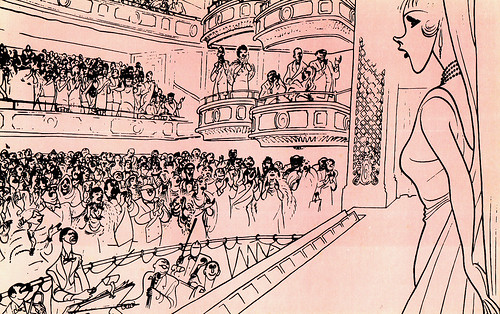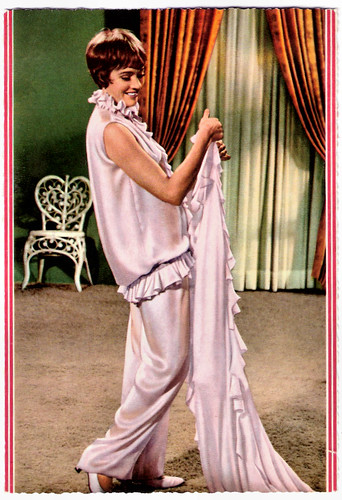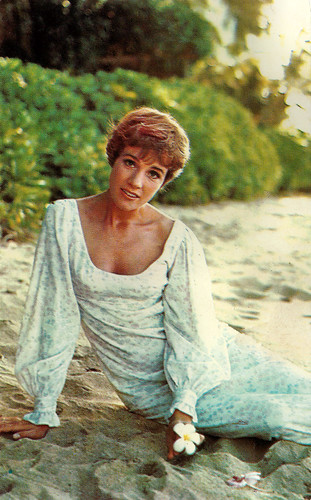
Italian postcard by Rotalcolor, Milano, no. 299.

Vintage postcard. Photo: still from Mary Poppins (1964).

French postcard by Les Presses de Belleville, Paris, no. 105. Photo: Walt Disney Productions. Julie Andrews and Dick Van Dyke in Mary Poppins (Robert Stevenson, 1964). Caption: The film that won 5 Oscars.

Romanian postcard by Casa Filmului Acin, no. 191. Julie Andrews in Thoroughly Modern Millie (George Roy Hill, 1967).
Big break
Julie Andrews was born Julia Elizabeth Wells in Walton-on-Thames, England, in 1935. Her mother, music hall performer Barbara Wells (née Morris), was married to Edward C. ‘Ted’ Wells, a teacher of metal and woodworking, but Andrews was conceived as a result of an affair her mother had with a family friend. With the outbreak of World War II, Barbara and Ted Wells went their separate ways. Ted Wells assisted with evacuating children to Surrey during the Blitz, while Barbara joined Ted Andrews in entertaining the troops. Barbara and Ted Wells were soon divorced and Barbara remarried to Ted Andrews in 1939.
Julie had lessons at the Cone-Ripman School, an independent arts educational school in London, and with the famous concert soprano and voice instructor Lilian Stiles-Allen. She continued her academic education at the Woodbrook School, a local state school in Beckenham. Julie performed spontaneously and unbilled on stage with her parents for about two years beginning in 1945.
She got her big break when her stepfather introduced her to Val Parnell, whose Moss Empires controlled prominent venues in London. Andrews made her professional solo debut at the London Hippodrome singing the difficult aria Je Suis Titania from Mignon as part of a musical revue called 'Starlight Roof' in 1947. She played the Hippodrome for one year.
In 1948 she became the youngest solo performer ever to be seen in a Royal Command Variety Performance. Julie followed her parents into radio and television and reportedly made her television debut on the BBC program 'RadiOlympia Showtime' in 1949. She garnered considerable fame throughout the United Kingdom for her work on the BBC radio comedy show Educating Archie (1950- 1952).
In 1954 on the eve of her 19th birthday, Julie Andrews made her Broadway debut portraying 1920s flapper Polly Browne in the already highly successful London musical 'The Boy Friend'. To the critics, Andrews was the stand-out performer in the show. In November 1955 Andrews was signed to appear with Bing Crosby in what is regarded as the first made-for-television movie, High Tor.

French postcard by Les Presses de Belleville, no. 101. Photo: Walt Disney Productions. Julie Andrews and Dick Van Dyke in Mary Poppins (Robert Stevenson, 1964).

French postcard by Les Presses de Belleville, no. 107. Photo: Walt Disney Productions. Still from Mary Poppins (1964).

French postcard. Photo: Walt Disney Productions. Julie Andrews and Dick Van Dyke in Mary Poppins (Robert Stevenson, 1964).

Spanish postcard by Ediciones Tarje Fher / Ediciones Mandolina, 1964. Photo: Walt Disney Productions. Still from Mary Poppins (1964).

Spanish postcard by Ediciones Tarje Fher / Ediciones Mandolina, 1964. Photo: Walt Disney Productions. Still from Mary Poppins (1964) with Dick van Dyke.
Oscars and Golden Globes
In 1956 Julie Andrews appeared in the Frederick Loewe and Alan Jay Lerner musical 'My Fair Lady' as Eliza Doolittle to Rex Harrison's Henry Higgins. Producer Moss Hart had mercilessly drilled her for 48 hours to help her get her lines, songs and dialect in proper working order. Richard Rodgers was so impressed with her talent that concurrent with her run in My Fair Lady she was featured in the Rodgers and Hammerstein television musical, Cinderella (Ralph Nelson, 1957). Cinderella was broadcast live and attracted an estimated 107 million viewers.
She married set designer Tony Walton in 1959 in Weybridge, Surrey. They had first met in 1948 when Andrews was appearing at the London Casino in the show Humpty Dumpty. The couple filed for a divorce in 1967.
Alan Jay Lerner and Frederick Loewe - also the composers of My Fair Lady - developed the role of Queen Guinevere in their musical Camelot (1960) with Andrews in mind. The result, Camelot, with Richard Burton, was another Broadway triumph However, studio head Jack Warner decided Andrews lacked sufficient name recognition for her casting in the film version of My Fair Lady; Eliza was played by the established film actress Audrey Hepburn instead. As Warner later recalled, the decision was easy, "In my business, I have to know who brings people and their money to a movie theatre box office. Audrey Hepburn had never made a financial flop."
Andrews played the title role in Disney's Mary Poppins (Robert Stevenson, 1964), a lavish musical fantasy that combined live-action and animation. Walt Disney had seen a performance of Camelot and thought Andrews would be perfect for the role of the British nanny who is "practically perfect in every way!" Andrews initially declined because of pregnancy. With her husband, she headed back to the United Kingdom in 1962 for the birth of daughter Emma Katherine Walton. But Disney politely insisted. As a result of her performance in Mary Poppins, Andrews won the 1964 Academy Award for Best Actress and the 1965 Golden Globe Award.
She and her Mary Poppins co-stars also won the 1965 Grammy Award for Best Album for Children. As a measure of ‘sweet revenge’, as Poppins songwriter Richard M. Sherman put it, Andrews closed her acceptance speech at the Golden Globes by saying, "And, finally, my thanks to a man who made a wonderful movie and who made all this possible in the first place, Mr. Jack Warner." Next, she appeared opposite James Garner in The Americanization of Emily (Arthur Hiller, 1964), which she has described as her favourite film.

Austrian postcard by Colorama Verlag, Salzburg. Julie Andrews in The Sound of Music (Robert Wise, 1965). Caption: Salzburg - Home of the Sound of Music. Its characteristically large, symmetrical flower-beds make Mirabell Gardens a good example of a typical baroque park. Some of the lovely choreographed singing scenes of the movie were filmed here.

Austrian postcard by MM-Verlag, Salzburg, no. FS 3000. Photo: publicity still for The Sound of Music (Robert Wise, 1965).

Romanian calendar card by Casa Filmui Acin. Collection: Alina Deaconu. Julie Andrews in The Sound of Music (Robert Wise, 1965).

Belgian postcard by Raider Bounty Joepie. Julie Andrews in The Sound of Music (Robert Wise, 1965).
The Sound of Music
Now, Julie Andrews was a real star, and it was her star power that helped make her third film, The Sound of Music (Robert Wise, 1965), the highest-grossing film of its day and one of the highest-grossing of all time. For her role as Maria von Trapp, she won her second Golden Globe Award in 1966 and was nominated for the 1965 Academy Award.
After completing The Sound Of Music, Andrews appeared as a guest star on the NBC-TV variety series The Andy Williams Show, which gained her an Emmy nomination. She followed this with an Emmy Award-winning color special, The Julie Andrews Show in 1965.
By the end of 1967, Andrews had appeared in the television special Cinderella; the biggest Broadway musical of its time, 'My Fair Lady'; the largest-selling long-playing album, the original cast recording of 'My Fair Lady'; the biggest hit in Disney's history, Mary Poppins; the highest grossing movie of 1966, Hawaii (George Roy Hill, 1966); the biggest and second biggest hits in Universal's history, Thoroughly Modern Millie (George Roy Hill, 1967) and the espionage thriller Torn Curtain (Alfred Hitchcock, 1967); and the biggest hit in 20th Century Fox's history The Sound of Music.
Then, Andrews appeared in Star! (Robert Wise, 1968), a biopic of Gertrude Lawrence, and Darling Lili (Blake Edwards, 1970), co-starring Rock Hudson, but both films bombed at the box office. The problem was that audiences identified her with singing, sugary-sweet nannies and governesses, and could not accept her in dramatic roles.
She married American director Blake Edwards in 1969. Hal Erickson at AllMovie: "By marrying Edwards and aligning herself with him creatively, then, Andrews was also consciously or unconsciously bucking to change her image." They adopted two children from Vietnam: Amy in 1974 and Joanna in 1975.

Vintage American postcard. Caricature by Al Hirschfeld. Caption on the back: “JULIE ANDREWS as the STAR! Drawn by the distinguished American artist, Al Hirschfeld, during a visit to the set of the Robert Wise Film, STAR !, directed by Robert Wise, produced by Saul Chaplin and released by 20th Century Fox.” Collection: Marlene Pilaete.

Italian photo by Rotograph, Roma. Photo: 20th Century Fox. Publicity still for Star! (Robert Wise, 1968).

Italian photo by Rotograph, Roma. Photo: 20th Century Fox. Publicity still for Star! (Robert Wise, 1968) with Daniel Massey.

Italian photo by Rotograph, Roma. Photo: 20th Century Fox. Publicity still for Star! (Robert Wise, 1968) with Richard Crenna.
Bared breasts
Julie Andrews continued working in television. In 1969 she shared the spotlight with singer Harry Belafonte for an NBC-TV special, An Evening with Julie Andrews and Harry Belafonte. In 1971 she appeared as a guest for the Grand Opening Special of Walt Disney World, and that same year she and Carol Burnett headlined a CBS special, Julie and Carol At Lincoln Center.
In 1972–1973, Julie Andrews starred in her own television variety series, The Julie Andrews Hour, on the ABC network. The show won seven Emmy Awards, but was cancelled after one season. Between 1973 and 1975, Andrews continued her association with ABC by headlining five variety specials for the network. She guest-starred on The Muppet Show in 1977 and appeared again with the Muppets on a CBS-TV special, Julie Andrews: One Step Into Spring, which aired in 1978.
Then, she returned to the cinema with an appearance in 10 (1979), directed by her husband Blake Edwards. He helped to keep her on the rise by directing her in subsequent roles that were entirely different from anything she had done before. There was the film star Sally Miles who bared her breasts on-screen in S.O.B. (1981), and the woman (Victoria Grant) playing a man (Count Victor Grezhinski) playing a woman in Victor Victoria (1982).
At IMDb, Tommy Peter writes: “The sheer novelty of seeing Julie Andrews in these roles, not to mention her brilliant performances in both of them, undoubtedly helped make them successes”. Her roles in Victor/Victoria earned Andrews the 1983 Golden Globe Award for Best Actress, as well as a nomination for the 1982 Academy Award for Best Actress, her third Oscar nomination.
Victor/Victoria was followed by Edwards's François Truffaut remake, The Man Who Loved Women (Blake Edwards, 1983) with Andrews as the lover of sculptor Burt Reynolds and the excellent mid-life crisis comedy-drama That's Life! (Blake Edwards, 1986), starring Andrews and Jack Lemmon. In 1987, she starred in an ABC Christmas special, Julie Andrews: The Sound Of Christmas, which went on to win five Emmy Awards. Two years later she was reunited for the third time with Carol Burnett for a variety special which aired on ABC in 1989.

Vintage postcard made in Hong Kong.

Mexican postcard by Sello, no. 230. Collection: Marlene Pilaete.

German postcard by Krüger, no. 902/410.

Romanian postcard by Filmului Acin, no. 43078.
Career Revival
In 1991 Julie Andrews made her television dramatic debut in the ABC made-for-TV movie, Our Sons (John Erman, 1991), co-starring Ann-Margret. The following year she starred in her first television sitcom, Julie (1992), which co-starred James Farentino.
In 1995 she starred in the stage musical version of Victor/Victoria, her first appearance in a Broadway show in 35 years. She was forced to quit the show towards the end of the Broadway run in 1997 when she developed vocal problems. She subsequently underwent surgery to remove non-cancerous nodules from her throat and was left unable to sing.
In 1999 she was reunited with James Garner for the TV film, One Special Night (Roger Young, 1999). In the 2000 New Year's Honours, Andrews was made a Dame Commander of the Order of the British Empire (DBE). She had a career revival when she appeared in The Princess Diaries (Garry Marshall, 2001), her first Disney film since Mary Poppins (1964). She starred as Queen Clarisse Marie Renaldi and reprised the role in a sequel, The Princess Diaries 2: Royal Engagement (Garry Marshall, 2004). In The Princess Diaries 2, Andrews sang on film for the first time since having throat surgery.
Andrews continued her association with Disney when she appeared as the nanny in two 2003 made-for-television movies based on the Eloise books, a series of children's books by Kay Thompson about a child who lives in the Plaza Hotel in New York City. The same year she made her debut as a theatre director, directing a revival of The Boy Friend, the musical in which she made her 1954 Broadway debut. In 2004 Andrews performed the voice of Queen Lillian in the animated blockbuster Shrek 2 (2004), reprising the role for its sequels, Shrek the Third (2007) and Shrek Forever After (2010).
She narrated Enchanted (Kevin Lima, 2007), a live-action Disney musical comedy that both poked fun and paid homage to classic Disney films such as Mary Poppins. In 2007 Andrews was honoured with the Lifetime Achievement Award at the Screen Actors Guild's awards and stated that her goals included continuing to direct for the stage and possibly produce her own Broadway musical.

American postcard by Coral-Lee, Rancho Cordova, CA, Personality no. #60/1980. Photo: Douglas Kirkland / Contact, 1980.

Romanian postcard by Casa Filmului Acin, no. 201.

Dutch collectors card.
London come-back
Julie Andrews published Home: A Memoir of My Early Years (2008), which she characterised as 'part one' of her autobiography. Home chronicles her early years in UK's music hall circuit and ends in 1962 with her winning the role of Mary Poppins.
For a Walt Disney video release, she again portrayed Mary Poppins and narrated the story of The Cat That Looked at a King in 2004. In 2010, Andrews made her London come-back after a 21-year absence (her last performance there was a Christmas concert at the Royal Festival Hall in 1989).
She also maintained her status as a family film icon by voicing Gru's mother in the animated Despicable Me (Pierre Coffin, Chris Renaud, 2010), and playing opposite The Rock in Tooth Fairy (Michael Lembeck, 2010). Her husband Blake Edwards passed away in 2010 at the age of 88. In 2011, Andrews received a Grammy Lifetime Achievement Award and, with her daughter Emma, a Grammy for best-spoken word album for children (for A Collection of Poems, Songs and Lullabies).
At the age of 77, Andrews undertook her first tour of Australia and New Zealand in 2013. The tour was hosted by Nicholas Hammond who was a boy of 14 when they appeared together in The Sound of Music. In place of singing, she planned a series of speaking engagements in the five mainland state capitals.
Julie Andrews has long had something of a dual image, being both a family-friendly star and an icon for gays and lesbians. Andrews herself has acknowledged her strange status, commenting that "I'm that odd mixture of, on the one hand, being a gay icon and, on the other, having grandmas and parents grateful I'm around to be a babysitter for their kids."
Trailer Cinderella (1957). Source: Dylles (YouTube).
Original 1964 Mary Poppins Theatrical Trailer. Source: ThreeDogShampoo (YouTube).
Original Trailer of The Americanization of Emily (1964). Source: SupportingActor (YouTube).
Trailer of Torn Curtain (1966). Source: MovieTrailersGuy (YouTube).
Trailer of Star! (1968). Source: S7ilver (YouTube).
Julie Andrews guest stars on The Muppet Show (1977-1978) and sings The Lonely Goatherd. Source: Sparklesinbrum (YouTube).
Trailer SOB (1981). Source: JLEPSS96 (YouTube).
Trailer Victor/Victoria (1982). Source: GayMovieReviews (YouTube).
Sources: Hal Erickson (AllMovie), Tommy Peter (IMDb), Wikipedia, and IMDb.
1 comment:
Great post! And thanks for the wonderful postcards! They arrived yesterday. Am looking forward to the Roger Moore post.
Post a Comment